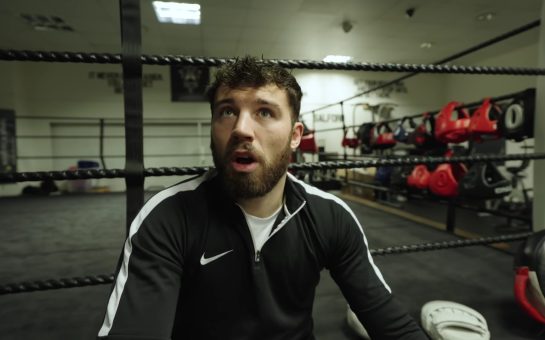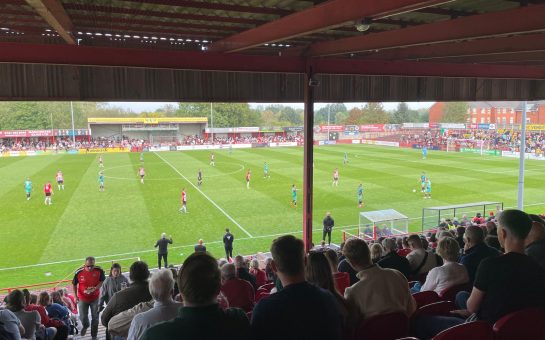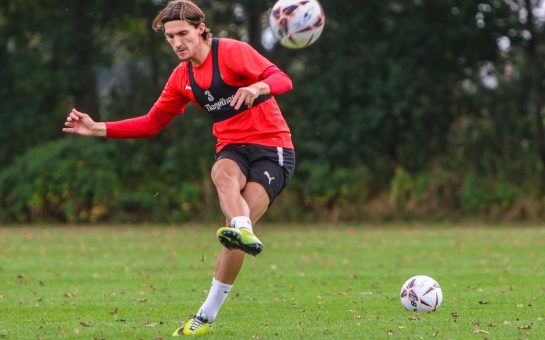Manchester Storm forward Wade MacLeod follows specific ice hockey training methods to ensure his body and mind are engaged for his time on the ice.
The left winger drills for 30-45 second bursts of activity which he says make the sport the most explosive besides mixed martial arts.
The 34-year-old has a regime with Finnish coach Kai Heinonen which began in his first year as a college player at Northeastern University.
As well as running through their drills, the two work together at Headway Hockey, a company founded by the Canadian player to coach and develop prospective and current on-ice talent.
The experienced personal trainer works with the player equipped with knowledge of the commitment and strength within. MacLeod had four surgeries on his brain between 2013 and 2018.
In fighting cancer and the recoveries he cites the Finn as helping bring him back to game readiness each time saying he’ll always find another gear to push the player harder. Here he shares some of the subtleties of specific ice hockey training and game preparation.
Mancunian Matters: In sports, it’s often said that the best players see ‘the first five-yards’ in their heads. So given the speeds of hockey and dimensions of the rink, how important is training for anticipation and getting to the puck first, or positioning yourself to be ahead of the play?
Wade Macleod: Meditation and visualisation are so key. And the best athletes don’t even know they’re doing it. They have it instilled in their brains, that, ‘okay, you’re gonna be here, I’m gonna be two steps ahead of you’. Whether or not they know it, like meditation and visualisation is so huge and something that’s we take pride in.
MM: Who would you say, in your hockey career, best epitomised that in-built ability just to know where to be. Any names?
WM: Yeah, so a lot of goalies visualise and I played with Cam Atkinson, who’s an incredible hockey player and he always knew where to be, whether or not he visualised it or meditated on it.
He knew exactly where to be. He was a prolific goalscorer and still is in the NHL, playing for the Philadelphia Flyers.
MM: He was the benchmark for you?
WM: I was in the American Hockey League for the same year and like, I looked up to him for positioning and scoring goals. He seemed to have it all.
MM: What advice would you give to the family of a junior who’s ready to take the first steps in their training programme?
WM: That’s who we basically want in our programme. If they’re willing to step right in and work hard, this is the training for them. And if they’re not willing to work hard, they tend to skip a day, or skip two days a week, or skate on the wrong days. That’s the biggest thing for the off season, is skating on the right days.
If they skate five days a week they won’t see any improvement in their off-ice times, or reps or sprints because as you know, or as you may not know, hockey is the most explosive sport besides mixed martial arts.
But you only need two or three days in your off-season to train on-ice training and five days a week in the gym because during the season you’re skating six days a week. So you don’t have time to strengthen your legs.
You have to maintain good balance. I do balance training twice a week. You’ve got to maintain a good core and then you just have to maintain your upper body.
MM: What subtleties are there in the training schedules between a goaltender, or a defenceman or a forward?
WM: Kai believes that the forwards and defencemen should train exactly alike.
MM: Is that because of the interchangeability of the positions during a game?
WM: Yep, and you have someone that’s super fast forward but they can’t skate backwards. So we try and incorporate that into our training – on-ice training, off ice training.
And for the goalies, it’s the most important position for hockey. The goalies have to be well-conditioned…goalies have to focus and sit in the stance, like a 90 degree bend for up to two minutes, so the goalie’s got to be the most explosive athlete on the ice.
MM: Do the outfield players ever time themselves against the goalies in that stance?
WM: The goalies will always win.
MM: Does good physical, mental and positional training for hockey help a player avoid physical confrontation and hits? Is it designed to do that given the amount of injuries that happen against the boards, for example?
WM: I can speak to experience. My muscle atrophy is tip-top because of the progressional pre-game warm up. I have little to no injuries. And the side of mental strength is just as important.
MM: Physicality and skating efficiency, power and subtlety – which is the most difficult to train towards achieving?
WM: I constantly train my skating every summer – every day. Probably the most difficult to train for is the fluidity. The strides are so fluid that you can’t really teach that.
MM: Apart from just drilling and drilling?
WM: Yeah.
MM: Hockey is considered one of the fastest of the team sports that involve shooting an object into a goal. What training methods are utilised to adapt to the speed of the game?
WM: For instance, we do everything as explosive as possible and then we get on the ice. Then we do what’s called ice plows. So we have to everything at top speed, handle the puck at top speed, release the puck at top speed.
MM: Which of the training routines which are skipped too often, do you think?
WM: Warming up is probably the hardest thing to instil in a hockey player. We often play sewer ball, like two touch with a football and some guys say ‘that’s it for warm ups’ and ‘you’re gonna warm up on the ice’ but there’s a whole different aspect to this training that we have to do progressional pre-game warm ups for up to 20 minutes getting our gear on and oftentimes I’m sweating and I see some of the other guys doing the same thing.
But imagine if everyone did that in hockey, how explosive and how the first period would be. A lot of the times, the first periods are kinda so slow moving for the first ten minutes.
MM: Could you support that methodology by linking it to perhaps, injuries that players might get in that first ten minutes?
WM: Yes. Everything is to do with stretching and warming up your legs. And oftentimes I see someone pull a groin in the first ten minutes. It’s very vital to have the warm-ups before you go on the ice.
(A 2016 report by Nathan Currier into the most injured NHL teams since the 2009-2010 season reveals that 48.1% of regular season injuries happen in the first period)
MM: How important is the trainer / coach relationship with a player to aid that player’s development?
WM: I’ve been with Kai since my first year of college. What’s that? 14 years ago. He motivates me, he pushes me to the absolute limit. When I don’t want to be pushed anymore, he’ll find another gear and push me even harder.
Kai has helped me not only get back from one brain surgery…but two and three. So the second time I had brain surgery I got the OK from my doctors to start training and he brought me back to the professional rankings, and I did OK.
With third and fourth brain surgery, back to back, and I hadn’t played hockey for three and a half years and he brought me back to gain my strength after chemo…I was down to 160lbs, but I’m back to my playing weight at 188…absolutely I couldn’t have done it without Kai. And he pushes me and pushes me to where I’m comfortable.
Wade MacLeod plays in the English Ice Hockey League for Manchester Storm and is the founder of Headway Hockey. (www.headwayhockey.ca)
Image credit: Dean Woolley (EIHL)



